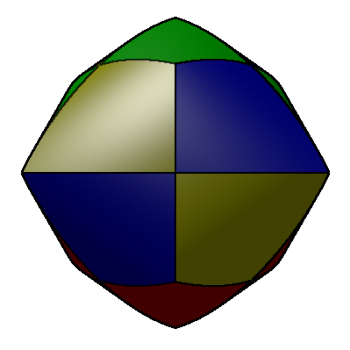Steinmetz gone wild
Let be the solid region in formed by intersecting four distinct solid circular cylinders of radius 1, with their axes running through the origin. If is the volume of and is the area of the boundary , find .
Bonus: What if we intersect such cylinders, with ?
(figure by Paul Bourke)

This section requires Javascript.
You are seeing this because something didn't load right. We suggest you, (a) try
refreshing the page, (b) enabling javascript if it is disabled on your browser and,
finally, (c)
loading the
non-javascript version of this page
. We're sorry about the hassle.
Consider the vector field F = ( x , y , z ) . By Ostrogradsky' theorem, Φ = ∭ W ∇ ⋅ F d V = ∭ W 3 d V = 3 V . But we also have Φ = ∑ all sides ∬ F ⋅ n d S = ∑ all sides ∬ ( x , y , z ) ⋅ ( x , y , 0 ) d S = ∑ all sides ∬ 1 d S = A . Hence A = 3 V . So 3 is the answer.
Note that the answer is independent of the number of cylinders n ≥ 2 . As long as at least one of the cylinders is distinct, V A = 3 .
Great thanks to prof. Otto Bretscher for the inspiration and a challenging semester of Vector Calculus!